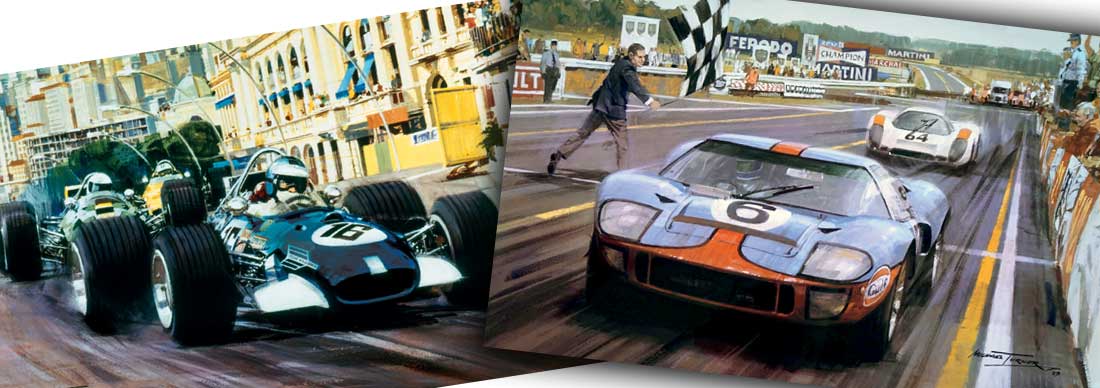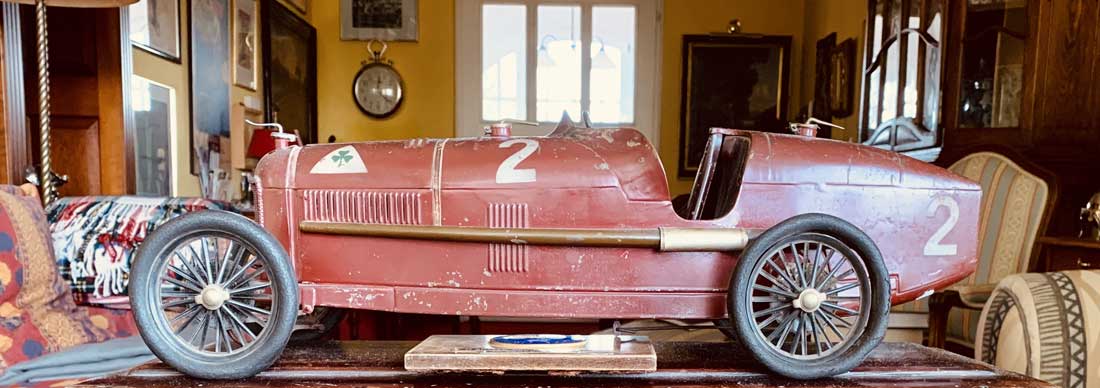
Selection of Michael Turner's Motorsport Paintings
Early in the season, Stirling Moss was seriously injured at Goodwood, ending his career. The championship was therefore between Graham Hill, in the BRM P57, and Jim Clark, in his Lotus-Climax 25, with Hill taking four wins to clinch the title.
A single set of six cards was produced in full colour with a white border, but the set included the 1961 cards of Stirling Moss (A10X) and Phil Hill (A15X), with only four new ones.
1962 British Grand Prix – Aintree (A22X)
Jimmy Clark winning the 1962 British Grand Prix
at Aintree in a works Lotus 25-Coventry Climax.
Jim Clark dominated the race, leading every lap from pole position and setting fastest lap along the way. He was chased by the Lola-Climax Mk 4 of John Surtees, but finished 49 seconds clear, with the Cooper-Climax T60 of Bruce McLaren third.

‘Aintree was an interesting place for a race, though the furthest part was pretty boring because it was alongside the horse race track, but some of the other parts, such as the Melling Crossing and this section after Anchor Crossing, had character. It’s hard to imagine now, but with a track pass you could walk around the outside of a corner on the grass. Maybe I stepped back a bit here, but I would usually try to go to the apex, which was always the safest place to be. If a car went off, it went outwards. To me it was stimulating an adrenaline rush. It’s hard for me to judge, but I like to think that is reflected in at least some of the pictures, because it is so exciting when you’re putting yourself that close to cars that are really racing.’
1962 Dutch Grand Prix – Zandvoort (A23X)
Graham Hill driving the works V-8 BRM to victory in the 1962 Dutch Grand Prix.
Jim Clark took the lead in the brand-new Lotus-Climax 25, chased by Graham Hill’s BRM P57, but Clark began to fall back with clutch problems. Hill was therefore left to take his maiden grand prix victory, ahead of the Lotus-Climax 24 of Trevor Taylor, with Phil Hill’s Ferrari 156 third.

‘Graham Hill, driving the V8 BRM, with jutting jaw and moustache, concentrating hard on the short stretch between Tarzan and the Hunzerug to keep ahead of Phil Hill’s Ferrari and Jim Clark’s Lotus. The stack-pipe exhausts were a feature of this BRM, and were inclined to work loose and fall off. There should be four on each side, but I recall at least one missing later in the race, as recorded here in the painting.’
1962 German Grand Prix (A24X)
John Surtees (Bowmaker Lola-V8 Coventry Climax) duelling with Dan Gurney (works V8 Porsche) for second place in the 1962 German Grand Prix at the Nürburgring.
Throughout the race, Graham Hill, in his BRM P57, battled in treacherous conditions with the Lola-Climax Mk 4 of John Surtees, seen in Michael’s painting, and the Porsche 804 of Dan Gurney, the three finishing in that order with just 4.4 seconds covering them after over two and a half hours of racing. Jim Clark, in his Lotus-Climax 25, made a poor getaway, but fought his way back up to fourth.

‘The Nürburgring in the dry is a daunting challenge for a racing driver, so in the wet, the chance of sliding off track into unforgiving surroundings is even more likely. Nevertheless, the 1962 race produced a race-long battle for the lead, with Graham Hill, driving the BRM, producing a typically gritty and determined performance to win. Always within striking distance, and adding to the pressure, were John Surtees in the Bowmaker team Lola, and Dan Gurney in the works Porsche, seen here negotiating the 180˚ corner before the short climb up to the Karussell. Gurney is making a brave attempt to pass round the outside, a move resisted by Surtees, who was not a man to give in easily. The pair maintained their positions to finish second and third, and as I had already recorded Graham’s win at Zandvoort for the cards, I was happy to produce this painting of the runners-up.’
1962 Monaco Grand Prix – Monte Carlo (A25X)
Bruce McLaren winning the 1962 Monaco Grand Prix in the V8 Cooper-Coventry Climax.
Jim Clark took pole in the Lotus-Climax 25, but was held up by an accident at the first corner, which allowed Bruce McLaren, in his Cooper-Climax T60, to take the lead, chased by the BRM P57 of Graham Hill, who moved ahead on lap seven. Meanwhile, Clark was charging through the field and made it up to second place before clutch problems caused him to retire. When Hill’s engine expired eight laps from the end, it meant McLaren took victory ahead of the Ferrari 156s of Phil Hill and Lorenzo Bandini.

‘Bruce was a super bloke and such a nice man. I was so pleased he won Monaco. There were just straw bales along the side of the track here, and there were men in a little boat, moored just off the chicane, because when Ascari, or later Paul Hawkins, went into the harbour, they were there to rescue them. I thought, this doesn’t happen very often fortunately, but they obviously had to cover that eventuality. If you walked up there on the edge of the harbour, there wasn’t much space. There were bollards for yachts to tie up to in normal times, which are still there and have to be got round, so there was little space there for a non-swimmer.’
1969
1969 British Grand Prix – Silverstone (B13)
Jochen Rindt, Lotus-Ford, contesting the lead with Stewart’s Matra just before stopping to rectify damage to the rear aerofoil.
The British Grand Prix at Silverstone that year produced a titanic battle between the Gold Leaf Team Lotus-Ford 49B of pole-sitter Jochen Rindt and the Matra-Ford MS80 of Jackie Stewart. The pair lapped the entire field, sometimes swapping the lead more than once during a lap, until Rindt had to pit when a rear wing end-plate came loose and was rubbing against his tyre. He re-joined, but another stop for fuel dropped him to fourth at the finish. Stewart thus took the win, ahead of the Brabham-Ford BT26A of Jacky Ickx.

‘What a duel that was. Their battle reached a turning point when Jackie Stewart was indicating to Rindt down the straight, driving alongside, that there was something wrong with his left-rear endplate which was splitting and, of course, that set him back eventually. If it wasn’t for that, I think that duel would have gone on right to the end. This is just after Becketts, as it used to be, coming onto the Hangar Straight down to Stowe, and the damage to Jochen’s endplate is very obvious.’
1969 Monaco Grand Prix – Monte Carlo (C13)
The battle for second place between the Brabham-Fords of Piers Courage and Jacky Ickx, seen as the cars breast the hill up to the Casino.
Early leader Jackie Stewart in the Matra-Ford MS80 had pulled out a gap of 20 seconds over the rest of the field when he ground to a halt with a broken universal joint. This allowed Graham Hill, in his Gold Leaf Lotus-Ford 49B, to score his fifth Monaco win. Hill had been battling with the Ferrari 312 of Chris Amon, but when this retired with a broken differential, Piers Courage brought his Frank Williams entered Brabham-Ford BT26A to a well deserved second place.

‘Another lovely spot at Monaco, coming up the hill towards Casino Square. It’s a pity that, with all the building work that was going on at the time, they demolished a building that had a large copper dome on the roof a bit further down the hill. There was a new building going up there, although I tried to hide it in the background as much as possible, but if I’d put the dome in it would have been wrong. It’s still a lovely place, with all the awnings and the shopping arcade there. Piers Courage was very talented as well, but sadly he died too young.’
1969 Le Mans (D13)
The most exciting finish ever at Le Mans, with the Ickx/Oliver Ford GT40 just beating the Herrmann/Larrousse Porsche across the line.
Jacky Ickx decided to protest at what he felt was a dangerous start procedure, where the drivers ran across the track to their cars, which were parked in echelon formation in the pits, and set off, often without securing their seat belts. The Belgian walked across to his JWAE entered Gulf Ford GT40, which he shared with Jackie Oliver, carefully did up his seatbelts and set off last of the runners. He crossed the line 24 hours later, just 120m ahead of the Porsche 908 Coupé LH of Hans Herrmann and Gerard Larrousse, with Herrmann at the wheel, after an enthralling final hour, during which the two leaders constantly swapped places.

‘As it happens, I think it was a year I missed going to Le Mans. I obviously knew about the close finish and the fact that Ickx had strolled across the road at the start because he didn’t agree with the Le Mans start, and he so nearly lost the race because of that. But it was such an amazingly close finish after 24 hours of racing, that this had to be the moment to record in a painting.’
Above text by Chas Parker & Michael Turner
All images above are copyright of Michael Turner
Click on the following link for more information on the Michael Turner Collection







Leave a comment
This site is protected by hCaptcha and the hCaptcha Privacy Policy and Terms of Service apply.